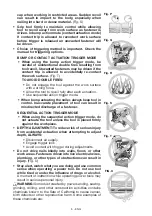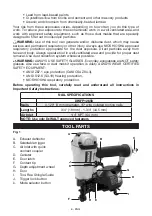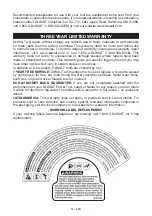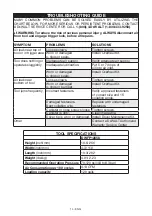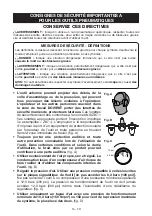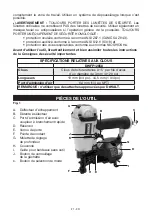
10 - ENG
Contact actuation trigger mode -
(Fig. 8)
The contact actuation trigger is intended for rapid
fastening on flat, stationary surfaces.
Using the contact actuation trigger mode, two
methods are available:
place actuation and contact
actuation.
To operate the tool using the PLACE ACTUATION
method:
1. Depress the contact trip against the work surface.
2. Pull the trigger to drive the fastener.
3. Allow the tool to recoil off the work surface
To operate the tool using the CONTACT
ACTUATION method:
1. Pull the trigger.
2. Depress the contact trip against the work surface. As long as the trigger is pulled,
the tool will drive a fastener every time the contact trip is depressed. This allows
the user to rapidly drive multiple fastener in sequence.
Changing the Actuation Mode -
WARNING: To reduce risk of serious injury, disconnect tool from air supply before
changing actuation mode.
1. Push the (black) trigger lock button down
2. Rotate the (black) selectable trigger button counterclockwise
3. Align the triangular indicator to the desired mode
•
For Sequential Mode
•
For Contact Mode
4. Then push the trigger lock button back up to the un-locked position.
ADJUSTING DEPTH (FIG. 9)
WARNING: To reduce risk of serious injury from
accidental actuation when attempting to adjust depth,
ALWAYS:
• Disconnect air supply and engage trigger
lock.
• Avoid contact with trigger during adjustments.
The depth that the fastener is driven can be adjusted
using the depth adjustment next to the trigger of
the tool.
The depth of drive is factory adjusted to
a nominal setting. Test fire a fastener and check
depth. If a change is desired:
1. To drive the nail shallower, rotate the depth setting wheel (G) to the right.
2. To drive a nail deeper, rotate the depth setting wheel (G) to the left.
The adjustment knob has detents every 1/4 turn. Test drive another fastener and check
depth. Repeat as necessary to achieve desired results. The amount of air pressure
required will vary depending on the size of the fastener and the material being
fastened. Experiment with the air pressure setting to determine the lowest setting that
will consistently perform the job at hand. Air pressure in excess of that required can
cause premature wear and/or damage to the tool.
Fig. 9
G
Fig. 8
C
Trigger lock button
Trigger mode selector button





